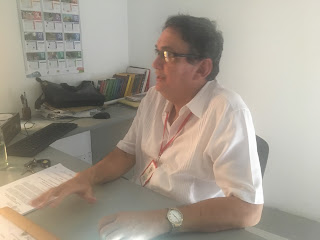CARTAGENA, COLOMBIA
I visit Cartagena, Colombia, between 6-9 May 2018 to learn about this World Heritage City since 1984. The old city is surrounded by 13 km of fortress that in the past functioned as the largest slavery trading post in the South of America. No wonder that Cartagena breaths slavery history in its daily life even in 2018. Actually this year Cartagena celebrates influence of African legacy by creating various programs and developing African heritage trails.
I met Alfonso Cabrera, the Head of Heritage Division in IPCC (Instituto de Patrimoni Y Cultura de Cartagena), a body that responsible for cultural heritage in Cartagena. He is a restoration architect specialised in fortification. His enthusiasm was very obvious about sharing and cooperation with other countries even as far as Indonesia with 450 fortresses.
If you are interested in checking his doctoral research (he did in Spain), this is the link.
 |
| Alfonso Cabrera, the Head of Heritage Division of IPCC |
 |
| The evaluation and action plan of Cartagena de Indias World Heritage City 2018-2033 |
 |
| The office of IPPC |
In his division, he is the only one who has a permanent position assisted by 25 staff with temporary contracts. Heritage is a tough business indeed. They in charge for 125 fortresses in Cartagena including monastery that used to be transformed into jails. In the old city, they in charge to control and to assist 1700 historical built heritage which are only 20 of them belong to government and the rest are owned by private sector and church institutions.
Although Cartagena has received a World Heritage Status in 1984 but they have to be alert continously since new development never stops. This year they have organized a conference to evaluate their ups and downs with policies and practices. The result is a new breath of action plan and policy until 2033.
I think Cartagena can be an interesting comparison for other fortressed cities in the world.



Comments